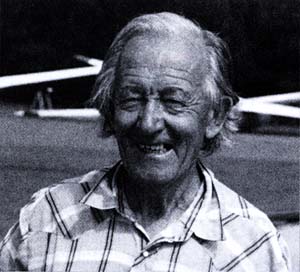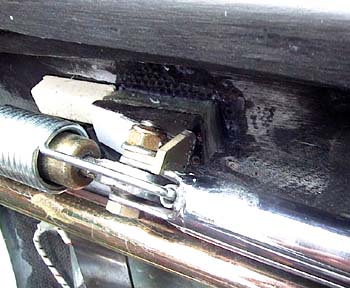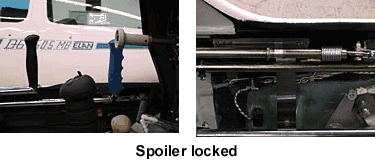The Piggott-Hook for locking the Brake Handle or How an Invention Begins
 SSA-Convention 2000 in Albuquerque – the third day. Im sitting flat-footed in our show booth and playing with my computer. An older man hurries up to me, grabs my arm, and drags me through the crowded convention hall to our DG-800S on display.
SSA-Convention 2000 in Albuquerque – the third day. Im sitting flat-footed in our show booth and playing with my computer. An older man hurries up to me, grabs my arm, and drags me through the crowded convention hall to our DG-800S on display.
“I have a suggestion for a safety device. It is important and it is cheap”, he said as we walked.
What does he want? I thought. What was his name did he say? Wasnt it something like Derek Piggott? And didn’t he look like the photographs in various gliding magazines published in English? Was this THE Derek Piggott? The most famous glider pilot in the English speaking world??
He kneeled immediately beside our glider and moved the brake handle back and forth while he explained his idea:
A mistakenly unlocked brake at the start of launch can get the pilot into danger of crashing.
That can be prevented by a dentent strip on the cockpit wall and a hook which fits it mounted on the brake push-rod.
The hook fits into one of the notches and cant move back by itself.
The pilot needs to only rotate the brake handle a little to free the detent mechanism.
Derek Piggott explained the various aspects of his suggestion. He gives the impression of being a wound up spring, a bundle of energy! The man also appears to be in command of a huge amount of experience.
Various ideas went through my head:
- I have already seen a motor-glider (ASK-16) launch with the brakes unlocked. He managed to clear the fence off the end of the runway but not the trees beyond! Luckily there was no injury to him but there was extensive damage to the glider.
- Many years ago, on our neighboring field, an older pilot winch launched and the brakes came open. He was unable to climb higher than 300 ft, spun in and was killed.
- According to Rainer Wienzek every year in southern France there are hairy situations in which the brakes come out on aero tow putting both pilots and aircraft in danger.
- In any case, this idea can work:
The usual spoiler found today, tends to fall of its own weight back into the wing when the brake handle is let loose. A suitable shape of the brake handle would allow that. But when the speed is high and the wings bend due to buffeting, the detent mechanism would prevent the spoilers from opening further. This would avoid a dangerous situation! It must work…….
Derek Piggott was waiting for my comments. He said that he had made this suggestion to all the other German sailplane manufacturers but none of them had caught on to the idea! This was my first SSA Convention and so he tried me this time. I could not promise him that we would start installing such a safety feature before I asked my engineers. But I did promise him that we would look at it closely at the factory in Bruchsal.
And thats what happened at my next visit to Bruchsal.
Wilhelm Dirks was totally in favor of it because there seemed to be very little cost. Also we had already done something similar with our parking brake. There are four teeth at the end of travel which hold the spoilers open. It was only necessary to extend the row of teeth forward and have three teeth in the opposite direction. Then it would work. However, all of our people were busy with the DG-1000 at the time. There didn’t seem to be time for this job until late autumn.
Oh well. I thought, Better late than never!
A few weeks later I took off with my DG-808B in Slovenia. The take off run was longer than usual but I didn’t think much about it. Then I noticed the climb rate was only 500 ft/min. With surprise I looked to the side and saw that the spoilers were open 2 inches.
Damn it all, Friedel!!
Fortunately for me that the DG-808B has a powerful motor. It climbs with partially deployed spoilers even if not as well as normally.
After the landing in the afternoon, I called Wilhelm Dirks still full of anger at my stupidity. I asked him to begin immediately on the spoiler handle safety.

I wrote to Derek Piggott about what happened to me and that DG had gone to work on the brake safety hook. He wrote back that he had regained his faith in the German sailplane manufacturers. I suggested to him that his idea be called the Piggott-Hook. That would give it a name like the well known Roger-Hook for the canopy but thats accidental of course.
In July, Wilhelm was able to show me a prototype which at first had only tooth.
I sent Derek a photo of it and we agreed to develop the production model and he could write an article about it for Sailplane and Gliding and Soaring and Motorgliding magazine. Soon afterwards we received the final version of the tooth and ratchet system and it does just what we wanted.

Or should we offer this and the parking brake as two optional items? The safety cockpit and the NOAH systems were offered as optional extras but these additions were much more expensive.
This is what we decided:
All gliders of the DG-800/DG-808 and DG-1000 series that are delivered after the end of year 2000 will have the Piggott-Hook and parking brake without a change in price.
Retrofitting this device to older 800Bs is now possible and highly recommended.
By the way, Im writing this again at 33,000 ft.
Does a Boeing 737 maybe have something like a Piggott-Hook also?
translated by David Noyes, Ohio
Here is the article written by Derek Piggott and published in some gliding magazines:
A safety device to prevent airbrakes opening on a launch
by Derek Piggott
Even today there are still many incidents all over the world where the airbrakes open during a launch and when the pilot is completely unaware that this has happened. This is one of the most serious hazards in glider flying today, yet it could be avoided altogether by a simple system which prevents the airbrakes opening, or opening further, if the pilot leaves them unlocked or partially open during the take off.
In the event of a launch failure or having to abandon the launch there is a very high risk of a serious accident if the airbrakes have opened. The very high drag and increased stalling speed can result in a stall/spin accident before the pilot has had time to recognize he has a problem.
With aerotow launching, on a number of occasions I have seen accidents when the pilot was waved off and attempted to turn back at low speed with the airbrakes open.
For many years I have been teaching glider pilots that if the tow plane is not climbing normally and the launch is rather slow, to immediately look out and check it was not because the airbrakes were open.
When this happens, the tow pilot usually suspects engine trouble because the lower revs on the engine caused by the extra drag and the slow flying speed. The glider pilot also suspects it is trouble on the tug, especially if the tow pilot has to give the wave off signal or jettisons the glider. In this situation the glider pilot will seldom suspect the real cause of the problem before the inevitable accident.
Of course today, the use of more powerful tow planes usually results in a positive climb and allows the combination to gain a safe height. The rudder waggling signal has also helped to eliminate the need for waving off the glider at low altitude.
With winch launching the biggest hazard if the airbrakes are open is the possibility of a launch failure at low altitude. The pilot has no time to realize that something is wrong and a stall and sometimes spin into the ground is almost inevitable and very serious.
After witnessing several of these accidents, I insisted that instructors put much more emphasis on the importance of proper pre-take off cockpit checks, and to teach the students to check that the airbrakes were not open by looking out sideways after leaving the ground. But even this only reduced the number of incidents and they still occur from time to time. We also emphasized that if anything seems unusual on any type of launch, always immediately check that the airbrakes are not open.
Pilots who have never had the airbrakes come open like this usually believe that they would spot the airbrakes were open during the launch and would quickly close them. However, I have seen many experienced pilots take off with the airbrakes unlocked and tow to a full launch height, release and
continue the flight with full airbrakes down to the approach, and sometimes even down to the landing itself without realizing what is causing so much sink!
It would seem that even glider pilots are human and do make mistakes. What is really needed is a means of preventing the airbrakes from extending themselves if the pilot, stupidly, leaves them unlocked or partially open during a launch.
At the last SSA Convention in Albuquerque I listened with interest to Herr Friedel Weber, the new President of the DG Flugzeugbau GmbH talking about the safety improvements on the latest DG models. I was impressed. Here at last was someone who recognized the need to make gliding safer if
possible and was prepared to do something about things.
I suggested to him that the airbrakes opening on the launch problem was still a major hazard on both aerotow and winch launches and that this was a simple and relatively inexpensive matter to put right.
At first like most other people, he was doubtful about the need for change. Was this really a serious hazard? Like everyone else he thought good cockpit drills do not allow it to happen. I believed that many years ago, and I have many gray hairs as a result of watching pilots risking their lives unnecessarily for the want of a good solution. When your gliding center makes over 30,000 launches of all kinds each year you see every type of hazard and pilot error and worry about them.
Dear Karl
Please tell me if you would rather not have the following paragraph in. It is not necessary and may cause you embarrassment, but I thought it may strengthen the case by showing a recent incident.
More recently, he wrote to tell me, he himself found his DG800 motor glider climbing poorly after take off, and you’ve guessed it, the airbrakes had opened! (I admire him for telling me this. It takes an honest pilot to admit that somehow they had slipped up and been careless.) This must have convince him of the need to incorporate something to eliminate this kind of hazard.
So now DG are leading the world by incorporating a system to prevent the airbrakes opening if the are inadvertently left unlocked and this will be available as a retro-fit on all DG models.
Almost any type of glider with an airbrake handle which has to be lifted away from the cockpit wall before pulling it to open the airbrakes can be easily modified to eliminate this risk. Of course this is no solution for the pilot who starts the take off with full airbrake, but we must hope that the wingtip holder or launch master sees this and stops the launch.
I am sure that this lead by the DG Company will result in such a device being introduced for all new gliders and, hopefully, to be used on many of the older types no longer in production. Such a modification can be very simple and inexpensive and I hope that all manufacturers will introduce similar systems and follow the DG example without delay.
This is a major step forward in the interest of making gliding safer for everyone and I am proud to be associated with it.
Derek Piggott
With regard to:
Retrofitting older gliders
It is a shame, but we have had terrible luck getting pilots to accept and retrofit new devices on older gliders. If its not a change required by the national aviation board, it is not done. Another way of putting this is if the use of automobile seat-belts were not mandatory, most drivers would probably still not be using them today!
A sad but true experience that causes us in the moment not to spend any money on developments for retrofitting on older gliders.
But now we can see that the reactions to this publication are very positive. This has caused us once more to check the possibilities:
A retrofit for the DG-100 and DG-300 is difficult, because the controls are completely other designed as for the flapped gliders. The demand for the DG-600 is very small, because there are only a few gliders.
For the DG-200 and DG-400 it is easier and so we designed a retrofit kit. It is published with Technical Notes.
For the DG-800 such a kit is available from the beginning.
Betreff: Good Show!
Von: Pete Williams
Dear KF:
I want to commend you and Wilhelm for the many improvements DG is incorporating into its sailplanes.
The 808B is the result and I am so happy to see that metal fittings and connectors are now standard in the fuel system.
Regardless of what the other factories are saying and doing (or not doing) DGs safety efforts will bear good fruit.
One life saved is adequate.
Keep on keeping on.
Best Regards,
Pete Williams
P.S. Would you please ship me the Roeger Hook Kit for my 800B 8-8B1?
Thanks
Betreff: dive brake lock (Piggott)
Von: Brian Evans
Firma: Convair Sailing Club
This device also has another use, with some types of motor glider when the pilot elects to land with the motor running,
there can arise a situation following a bounce during the landing.
The pilot lets go the dive brake lever and opens the throttle , the aircraft is in a semi stalled condition.
The pilot recovers from the bounce, lowers the nose to re-land the aircraft and the dive brakes pop out.
The aircraft stalls and drops hard from 2 to 3 meters damaging the landing gear and other things.
This device will also prevent this from happening.
Brian Evans (Formerly Evans Sailplane Repair)

